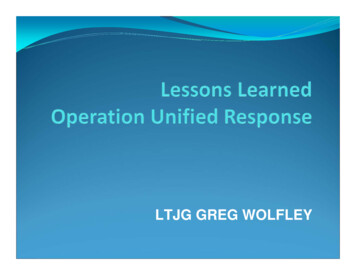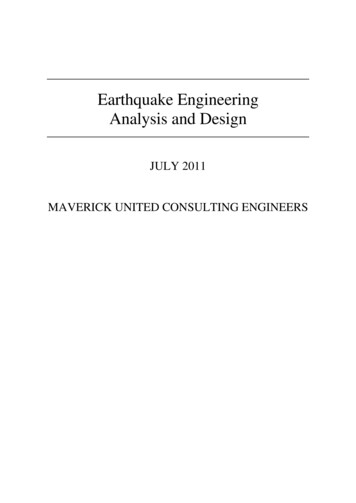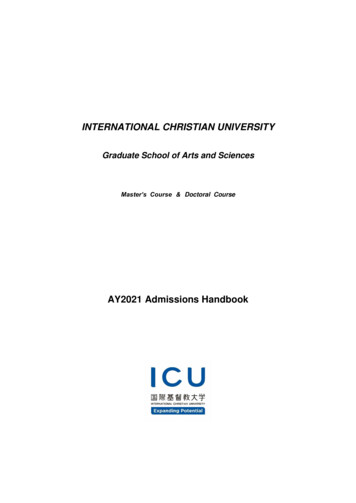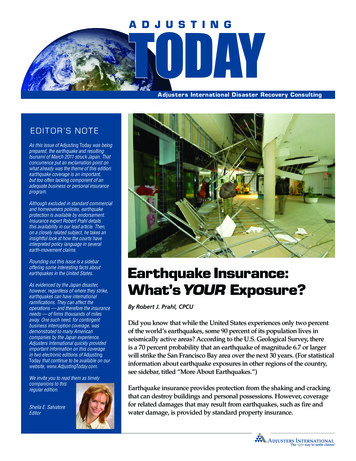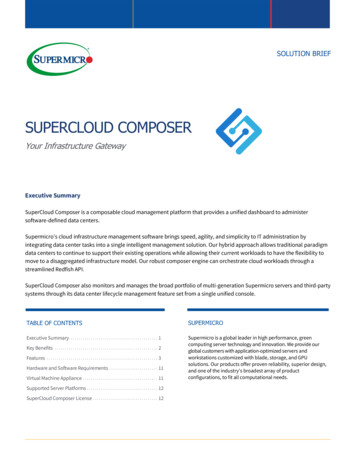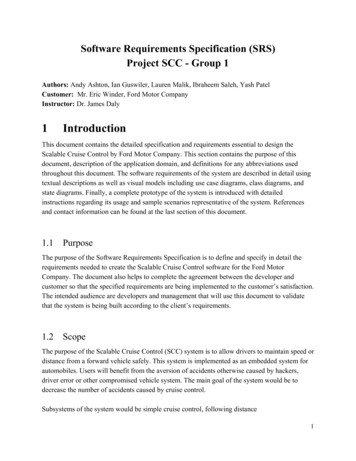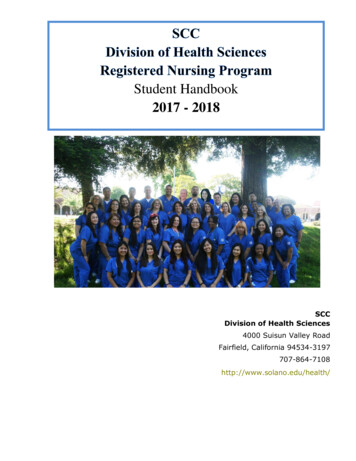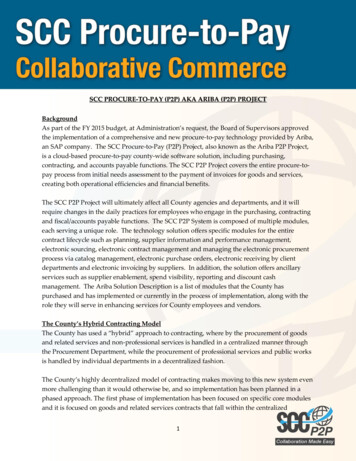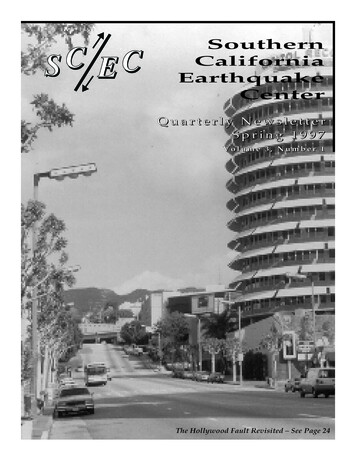
Transcription
CS ECSouthernCaliforniaEarthquakeCenterQuarterly NewsletterSpring 1997Volume 3, Number 1The Hollywood Fault Revisited – See Page 24
S C E C Southern California Earthquake CenterFrom thePage 2Center DirectorScience DirectorCenter Directors.Science intoPracticeThe Southern California Earthquake Center is primarily anational Science and Technology Center, with a mission to pushforward the science of earthquake hazard estimation. TheNational Science Foundation, which provides the largest share ofour funding, will evaluate our success primarily on the basis ofpublishable scientific results. On the other hand, we accept aresponsibility to help users of earthquake information who havehigh-stakes decisions before them. Specific efforts to reach usersinclude our “Phase I” report on the implications of the Landersearthquake for future earthquakes; the “Phase II” report on the 30year probabilities of earthquakes throughout all of California; theupcoming “Phase III” report which will add a comprehensivestudy of site effects, and a thorough uncertainty analysis; a majorcollaborative project with the City of Los Angeles and theStructural Engineers Association of Southern California on therisks posed to certain types of buildings; and numerous workshops with city, county, state, and industrial groups.We have learned that attention to the users does not compromisebasic science; rather, connecting research to practice sharpensboth. While forging the consensus reports we forced ourselves toask how best to read the geologic record, how much will thefuture resemble the past, whether strain accumulation signifiesexceptional earthquake potential, and why strong ground motionvaries so much from place to place. Old questions, yes, but nowmore focused and tangible. And the users are interested in thebasic research. They want to know the uncertainties, the implications of the models, and whether there are other viable hypotheses. Forthright answers to these questions will lead to betterL.economic and policy decisions andThomasto improvedpublic safety.Academic scientists and information users have far to go yet tounderstand each other, but the efforts to date have been extremelyconstructive.What Is the Southern California Earthquake Center?earthquakes will occur in southern California;The Southern California Earthquake Center (SCEC) activelycoordinates research on southern California earthquake hazardsand focuses on applying earth sciences to earthquake hazardreduction. Founded in 1991, SCEC is a National Science Foundation (NSF) Science and Technology Center with administrative andprogram offices located at the University of Southern California.It is co-funded by the United States Geological Survey (USGS).The center also receives funds from the Federal EmergencyManagement Agency (FEMA) for its Education and KnowledgeTransfer programs. The Center’s primary objective is to develop astate of the art probabilitistic seismic hazard model for southernCalifornia by integrating earth science data. SCEC promotesearthquake hazard reduction by:To date, SCEC scientists have focused on the region’s earthquakepotential. Representing several disciplines in the earth sciences,these scientists are conducting separate but related researchprojects with results that can be pieced together to provide someanswers to questions such as where the active faults are, how oftenthey slip, and what size earthquakes they can be expected toproduce. Current work focuses on seismic wave path effects andlocal site conditions for developing a complete seismic hazardassessment of southern California. Defining, through research, when and where future damagingInformation: Call 213/740-1560 or e-mail ScecInfo@usc.eduSouthern California Earthquake Center Quarterly Newsletter, Vol. 3, No. 1, Spring, 1997 Calculating the expected ground motions; and, Communicating this information to the public.
Page 3New Real-Time Information Technologies inManaging Earthquake Emergencies Presented atPasadena WorkshopLeft: Estimated Modified Mercalli Intensity forthe Northridge Earthquake based on modelsdeveloped for the Early Post-EarthquakeDamage Assessment Tool (EPEDAT). EQEInternational, Inc.M aking the Most of New Real-Time Information Technologies inManaging Earthquake Emergencies was the title of a one-day, midMarch workshop jointly hosted by the Southern CaliforniaEarthquake Center (SCEC), the US Geological Survey (USGS), theCalifornia Department of Conservation’s Division of Mines andGeology (CDMG), the California Emergency Services Association(SCESA), the Governor’s Office of Emergency Services (OES), andthe California Institute of Technology (CIT). The event wascoordinated by the Center for Advanced Planning and Research atEQE International, Inc.The workshop was designed to address the information andplanning needs of emergency services coordinators and managers, both public and private sector; public information officers;building and safety officials, and disaster planners and riskmanagers. A special invitation was extended to journalistsrepresenting both broadcast and print news media.Issues addressed by panelists and speakers included the challengeof major earthquake emergencies; new developments in earthquake monitoring in southern California; strong ground motion inreal time; new earthquake response and recovery tools; real timescientific assessment of major earthquakes; and future real timeinformation technologies.Above: TriNet, a joint project of the USGS,Caltech and the California Division of Minesand Geology, will integrate remote sensorsand centralized data analysis withautomated communication of the locationand severity of the earthquake.Los Angeles City Councilman Hal Bernson delivered the openingremarks, and commented on the importance of highlightingcurrent research to end users in the community. Althoughresponse and recovery efforts are enhanced by the rapid transferof scientific data and information, Bernson reminded participantsthat the value of preplanning must not be overlooked.Governor’s Office of Emergency Services (OES) Director RichardAndrews discussed the challenges and opportunities presented tous by new real-time technologies, and cited several ways the Statebenefits from innovative, technology-based programs such as theCalifornia Strong Motion Instrumentation Program (CSMIP), theCaltech-USGS Broadcast of Earthquakes (CUBE) system, theResponse Information Management System (RIMS), and the EarlyPost Earthquake Damage Assessment Tool (EPEDAT). These aredeveloping technologies and at times, user expectations exceedperformance levels of certain systems. But as Andrews pointedout, “a better solution tomorrow is preferable to the perfectsolution one or two years from now.”James Mori, Scientist-in-Charge, USGS Pasadena Office, andSee "New Technologies" on Page 4Southern California Earthquake Center Quarterly Newsletter, Vol. 3, No. 1, Spring, 1997
S C E C Southern California Earthquake CenterPage 4New Technologies continued from Page 3 .CDMG State Geologist James Davis both spoke about newdevelopments in earthquake monitoring in southern California.Davis recognized the challenge of producing strong motionreports on significant earthquake activity within 30 minutes, asopposed to a decade earlier when a similar report took up to 30days. The CDMG has collaborated with Caltech and the USGS inlaunching the TriNet Project, a state-of-the-art seismic monitoringnetwork for southern California, funded by the Federal Emergency Management Agency (FEMA), TriNet members, andseveral private-sector partners. TriNet is one of the new projectsfeatured at the workshop. Both Davis and Mori underscored theimportance of user feedback in determining the effectiveness ofreal-time capabilities in a response and recovery setting.critical systems, and source modeling for interpolation); engineered structures monitoring; and immediate mapping of verticaldeformation.Ronald Eguchi, Director of the Center for Advanced Planningand Research at EQE International, Inc., described recentmilestones achieved through development of GeographicalInformation Systems (GIS), introduction of real-time monitoringsystems, and the availability of comprehensive loss estimationtools, such as the OES’s new EPEDAT system and the NIBS/HAZUS program.In summary, workshop moderator Jill Andrews (SCEC) pointedout that while many of these “new” technologies have alreadybeen demonstrated in pilot projects, useful applications are nowemerging. These applications demonstrate the commitment on thepart of scientists, engineers, government representatives, andtechnical professionals to form partnerships and seek ways tointegrate, share information, and minimize duplication of effort.On the flip side, Andrews reminded participants of a questionasked by Jack Popejoy (KFWB Radio) during the public information panel (“What do we DO with early warning?”), whichrightfully raises concern about the growing number of social andpublic policy issues that must be addressed as we move into the“real-time” information age. Jill AndrewsKen Hudnut, Project Chief of Global Positioning Satellite (GPS)studies for the USGS in Pasadena, led the group through anoverview of real-time earthquake assessment using GPS. Threetypes of uses for GPS were described: Deformation field measurements (vertical deformation mapping, tilts and strains ofNSF “TIPSHEET” FEATURES SCECSCIENCE AND TECHNOLOGY CENTERS STIMULATENEW APPLICATIONS OUT OF BASIC DISCOVERIES: TheNational Science Foundation (NSF) established a program ofScience and Technology Centers in 1987 to exploit newopportunities in fundamental science and technology as wellas education. The centers are also designed to stimulatetechnology transfer and applications for various sectors ofsociety. NSF funds 24 centers with an operating budget ofmore than 60 million. A few examples of ongoing projects atmajor research institutions were featured, including thefollowing excerpt on SCEC’s outreach to a local government:NSF EARTHQUAKE CENTER EXPLORES SEISMICZONATION OPTIONSRecent earthquakes around Los Angeles, including the 1987 WhittierNarrows and 1994 Northridge events, have intensified scrutiny of theregion’s earthquake hazard plans. At a National Science Foundation Southern California Earthquake Center (SCEC) workshop in LosSouthern California Earthquake Center Quarterly Newsletter, Vol. 3, No. 1, Spring, 1997Following the general presentations and lunch, participantsdivided into four groups for panel sessions on emergency publicinformation, emergency response operations, building/facilityassessment and safety, and planning, policy and risk management.Panel moderators summarized each session in the final plenary.Pre- and post-event applications of the new technologies, futureplanning based on new capabilities, the need for a decisionsupport system, and facilities hardening were topics examined bythe groups.Angeles, engineers, earth scientists and city planners discussed thecurrent level of understanding about regional earthquake hazards andwhether new strategies might be implemented to reduce futureearthquake risks.“The primary goal was to find out to what makes sense, given ourcurrent level of knowledge about earthquake hazards in the L.A.region,” Tom Henyey, SCEC director, said. Henyey cited the ongoingconcern of risks to critical public facilities such as hospitals, schools,and emergency response centers, and the evaluation and retrofitting ofunreinforced structures.Participants reviewed implications of future code requirements fornew buildings and developed a plan that lays out the next steps forestablishing a vehicle for continuing dialogue, continuing theeducation of public officials about new scientific information andidentifying projects that would benefit the city over both the short-andlong-term.Cheryl Dybas, National Science FoundationFor more information on Science and Technology Centers,contact Beth Gaston (703) 306-1070.
Page 5Science Seminar NewsBeginnings of Earthquakes, Stress Triggers, andBorehole Initiative Featured in Spring '97 SeminarsFebruary.THE BEGINNINGS OF EARTHQUAKESHosted by Caltech, this SCEC-sponsored seminar was held onFebruary 20, 1997. Readers interested in seminar topics presentedshould access www.scec.org/calendar or the speakers for moreinformation.Topics addressed during the seminar were “Seismograms and thebeginnings of earthquakes” (Bill Ellsworth, USGS); “Nucleation ofunstable fault slip” (Jim Dieterich, USGS); “Looking at ruptureinitations across several orders of magnitudes from earthquakesequences in southern California” (Jim Mori, USGS); “Detailedobservations of California foreshock sequences: Implications forthe earthquake initiation process” (Doug Dodge, LLNL); “WhatWill it Take to Discriminate Between the Cascade and PreslipModels?” (Greg Beroza, Stanford); and “Prologram: Beginning ofEarthquakes and Its Implications for Earthquake Process” (HirooKanamori, Caltech).March.EARTHQUAKE STRESS TRIGGERS,STRESS SHADOWS, AND THEIRIMPACT ON SEISMIC HAZARDThe Southern California Earthquake Center and the United StatesGeological Survey co-hosted a two-day workshop held March 2122, 1997, at the U.S. Geological Survey in Menlo Park. Coconveners were Ross Stein, Ruth Harris, and Lynn Sykes. Thefocus of this meeting was to assess the strengths and weaknessesof stress-based analyses of earthquake sequences, earthquakeinteractions, and probabilistic earthquake hazard assessment.Earthquake interactions over both short (seconds) and long(decades) time scales; and static, dynamic and secular stresses,were pertinent.The workshop featured 25 invited talks, with 4 wide-open halfhour discussion sessions. Invited speakers were RenataDmowska and Jim Rice (Harvard), Lynn Sykes and Bruce Shaw(Lamont), Juliet Crider (Stanford), Dave Jackson and John Vidale(UCLA), Andy Freed (Univ. Arizona/WHOI), Susanna Gross(Univ. Colorado), Jeanne Hardebeck (Caltech), John Anderson(Univ. Nevada), Gene Humphreys (Univ. Oregon), Yehuda BenZion and Charlie Sammis (USC), Steve Ward (UCSC), Ross Stein,Ruth Harris, Bob Simpson, and Lucy Jones (USGS).The first session (convenor, Lynn Sykes) included an introductionby Stein and Harris, with presentations on the following subjects: Kobe and Northridge: Correlation of Stress Change withAftershocks, and Stress-based Probabilities Static Stress Changes and Earthquake Triggering during the1954 Fairview Peak and Dixie Valley Earthquakes, Central NV Model of Tectonic Stress State and Rate using NorthridgeAftershocks A Quantitative Look at Static Stress Change Triggering ofAftershocks: Where, When, and How Much Stress? Stress Change Induced by the 1992 Landers Sequence Detectedby Regional Seismicity in Southeastern California Effect of the 1989 Loma Prieta earthquake on nearby CreepingFault SegmentsThe second session (convenor, Ross Stein) included: Stress Shadows: Coulomb Failure Stress or Rate-and-State:Which Should be used to Identify Faults that will NOT Produce aLarge Earthquake in the next 5 or 10 or 50 Years? Time-dependent Stress Changes during Earthquakes Triggering of Earthquakes in the Far Field by Dynamic Waves Structural Heterogeneity: Modeled 3D Static Stress Distribution around Segmented Normal Faults Earthquake Stress Changes in Extensional Regimes: Evidencefrom the Central Apennines (Italy) Earthquake Triggering Effects with Time-dependent NucleationSecond day, first session (convenor, Ruth Harris) covered: Evolution of Stresses, Triggering of Earthquakes and Implications for Intermediate- and Long-term Prediction A Non-precursory Seismic Cycle Evidence for Temporal Clustering of Large Earthquakes in theWellington Region, New Zealand from Computer Models ofSee "SCEC Seminars" on Page 29Southern California Earthquake Center Quarterly Newsletter, Vol. 3, No. 1, Spring, 1997
S C E C Southern California Earthquake CenterPage 6Highlights of the Annual ReportEach year, SCEC produces an Annual Report that includes research focus summarystatements by working group leaders, proposals funded, and education andoutreach directors' program descriptions. We feature portions of them here forour readers, but in future years, we will make them available on the SCEC Webpages.Group A (Master Model)Group A concentrated on three foci in 1996: methods to estimateearthquake probabilities, sensitivity and uncertainty in probabilistic seismic hazard analysis, and hypothesis testing.Earthquake ProbabilitiesJackson, Kagan, Ge and Potter (University of California, LosAngeles) constructed a suite of source models for use in the PhaseIII report. The report will investigate the sensitivity of seismichazard analysis to major assumptions, provide realistic uncertainty estimates, add site corrections, and include a suite oftheoretical seismograms incorporating different methods. Varioussource models are being included to test the sensitivity of theresults to assumptions such as the characteristic earthquakemodel and maximum magnitudes. Models that have beendeveloped include a purely historic model based on historicearthquakes, a smoothed seismicity model with a uniformmaximum magnitude, a model based on geodetically observedstrain rate with a uniform maximum magnitude, a characteristicearthquake model based on geological slip rates only, and acombined geologic/geodetic model with both faults and areasources. The models are expressed in a form such that they can betested against future earthquakes, and they each match theobserved seismic moment rate so that in principle linear combinations of the these end-member models could also be used inhazard analysis. In developing the models, we also developed anew table of slip rate values, and a new earthquake catalog.Several investigators addressed the problem of estimating themaximum magnitude of earthquakes on a given fault or in agiven region, and how the maximum magnitude choice affects theestimates of earthquake frequency. Jackson and Kagan (UCLA)showed that if the maximum magnitude is uniform throughoutsouthern California, and if the b-value is 1, then Mmax must be atleast 8 to be consistent with both the historic seismicity rate andthe moment rate at the 95% confidence level. Stirling, Wesnousky,and Shimazaki (University of Nevada, Reno) concluded thateither a characteristic or Gutenberg-Richter model would fit theobserved seismicity and moment rate, if allowance was made forerrors in both the earthquake catalog and the models themselves,and if faults were assumed to rupture for their entire mappedlength. The characteristic earthquake model included earthquakesSouthern California Earthquake Center Quarterly Newsletter, Vol. 3, No. 1, Spring, 1997up to magnitude 8.1, but only on major faults. Ward (UC SantaCruz) examined the problem of maximum magnitude by studyingthe stress interactions between faults. He found that faultsbehave essentially independently if their separation exceeds 5% oftheir length, and that multi-segment triggering increased themaximum magnitude to only 0.3 units above the characteristicmagnitude.Working GroupStress InteractionStress interaction was a major topic of study, made especiallyinteresting as a hypothesis to explain why the observed earthquake rate might depart from the long term average during thehistoric period. Hardebeck (Caltech), Seeber (Lamont-Doherty),Lin (Woods Hole Oceanographic) & King (Massachusetts Instituteof Technology), and Sykes (Lamont-Doherty) each showed caseswhere earthquakes and other small shocks occur more frequentlywhere Coulomb stress has been increased by a previous earthquake, and less frequently where it has been reduced. Kagan,however, showed that the correlation between seismicity andCoulomb stress depends very sensitively on arbitrary choicessuch as earthquake catalog, fault geometry, etc. Sykes hypothesized that the 1812 and 1857 great earthquakes in southernCalifornia cast a stress shadow that prevented large earthquakesin much of the region. According to his hypothesis, the gradualaccumulation of tectonic stress could be accompanied soon by aresumption of large earthquakes close to metropolitan LosAngeles and San Bernardino. Humphreys (University of Oregon),Lin & King, and Seeber all made important technical improvements that will allow a more accurate stress model (includinginelastic relaxation and other nonlinear effects) and betterestimation of focal mechanism solutions to compare with theoretical stress effects. All are working on methods to estimate theeffect of stress transfer on earthquake probabilities. Ward hasdeveloped a quasi-static model that accounts explicitly for stressSee "Annual Report" on Page 7
Page 7Annual Report continued from Page 6 .interaction between faults segments, using a breaking criterionrelated to the rate/state friction laws developed recently byDieterich (USGS) and colleagues.Group B (Strong Motion Modeling)Probabilistic Seismic Hazard EstimationThe primary focus of Group B is on the prediction ofstrongmotion time histories. Ongoing work towar d this objectiveisdistributed among the following ar eas: (1) research on siteeffects, (2)development of gr ound motion estimates for L.A.Basin scenarioearthquakes, and (3) investigations of highfrequency focusing. Insupport of these ef forts, we are alsodeveloping ground motion andsite pr operties databases. Wherenecessary to improve themodeling methodologies or to betterunderstand their uncertaintiesand limitations, the working gr oupis also engaged in morefundamental r esearch on source and siteeffects. A summary ofpr ogress during 1996 follows.The Phase III Report will include sensitivity and uncertaintystudies, and several SCEC investigations are contributing to thiseffort. Mahdyiar (Vortex Rock Consultants) computed manyseismic hazard estimates at selected points in southern California,each time varying choices of important parameters or assumptions. He has investigated the effect of slip rate uncertainty, Mmax,and seismogenic thickness by choosing values at both limits ofacceptance. He has compared characteristic vs. GutenbergRichter magnitude distributions and models based purely ongeology, geodesy, and seismic history against one another.Cornell (Stanford) has explored the process of “deaggregation,” orfinding the parameters of earthquakes that contribute moststrongly to seismic hazard at a particular site. These parametersare then used to select hypothetical earthquakes, for whichtheoretical seismograms are calculated for use in building designand retrofit decisions. Wesnousky has compared several probabi-Summaries.listic hazard models directly, point-for-point. The report shows acomparison of predicted peak ground acceleration at 10%probability in 50 years on soft rock for three models: (1)Wesnousky (1996) used fault slip rates and paleoseismic data,assuming all earthquakes to be on mapped faults; Ward (1994)used a combination of geodetic and geologic data, and allowedmodel earthquakes on and off faults; and Frankel (USGS) et al.used geologic data and historical seismicity to determine earthquake probabilities, both on and off faults, in the combinedUSGS/CDMG model. Differences between models are quitesignificant, amounting to over 0.5 g at some locations. In generalthe Wesnousky model shows higher acceleration in a moreconfined area, the USGS/CDMG model shows a broader regionfor which the expected acceleration exceeds 0.5 g, while the Wardmodel is in between.Hypothesis TestingA major goal of SCEC is to develop procedures for testinghypotheses relevant to earthquake probabilities and seismichazard estimation. Jackson has developed a likelihood test forcomparing any forecasts that can be expressed as probabilitydensity functions in epicentral location, magnitude, and time.This method can be used to test the source model in the Phase IIReport and the alternate source models to be used in the Phase IIIReport.David JacksonObjectivesSite Effects ResearchDatabases The uppermost few tens of meters of the Earthis byfar the most accessible, and for most earthquake hazardstudies isthe only regime for which substantial site-specificinformation canbe expected. The SCEC C-cubed project hasacquir ed shearvelocity profiles for the uppermost 30 meters of thesubsurfaceunderlying a large number of strong motioninstr umentation sitesin Southern California. During 1996,V ucetic (UCLA) continueddevelopment of the SCEC geotechnicaldatabase of shallowgeotechnical properties for L.A. Basin sites. Strain-dependentmodulus and damping data were incorporatedinto the database,and the database was linked to software for thesimulation ofnonlinear site effects. During 1996, theydemonstrated thecapability to generate maps of site-modifiedgr ound motionthroughout L.A. Basin using this method.The UCSB group continued development of the StrongMotionand the Empirical Green’s Function databases (EGFDB). AnewW orldwide Web version of the Strong Motion Database(SMDB) is operational, makingdatabase access mor e convenientfor strong motion researchers andengineering practitioners. Asimilar approach is being planned forthe EGFDB. The EGFDBwill play an important role in effortsover the next year to sear chfor high-frequency focusing effects insouthern California, andwill be instrumental in simulations ofgr ound motion for scenarioearthquakes.Nonlinearity Most seismological methods for groundmotionsimulation assume that the approximations of linearelasticity ar eapplicable. The University of Nevada at Reno (UNR) group iscontinuing to modelsoil nonlinearity to assess the limits of thelinear methods anddetermine the seismically observable consequences of nonlinearity. This work is necessary in or der for us toassess the range ofconditions under which gr ound motionmodeling of the scenarioevents is valid without special corr ections for nonlinearity. It isalso important for understanding thephysical phenomenacontr olling empirical regression relationSee "Annual Report" on Page 8Southern California Earthquake Center Quarterly Newsletter, Vol. 3, No. 1, Spring, 1997
S C E C Southern California Earthquake CenterAnnual Report continued from Page 7 .ships. Nonlinear effectswer e found to be important at periodsless than 0.3-0.5 seconds, especially when the water table isshallow. At longer period, thenonlinear ef fect is substantially lessimportant. It was found that those PGA and SA regressionrelations in which the shape (i.e., the shape of the amplitudeversus-distance curve) is permitted to change with site conditionagree well with the theoreticalpr edictions at all distances.Scenario Ground Motion for L. A. BasinSeismic velocity structure for L. A. Basin Group B has as agoalthe modeling of ground motion from scenario earthquakes,takinginto account the complexity of regional geologic structure in3dimensions. This requires a model of earth structure withspatialr esolution comparable to seismic wavelengths of interest.Thislevel of r esolution is not currently possible from seismictraveltimes alone. The SDSU/Maxwell Labs team hascontinueddevelopment of geological and geotechnical constraintson thesouthern California seismic velocity model using data ongeologicinterfaces together with sediment compaction models. Inaddition,during 1996, Gr oups B and D collaborated in development of amethodology to integrate the geologic constraints withconstraintsfr om seismic travel time tomography. The modeling isbeingextended into the V entura Basin and the San BernardinoValley. Our practice has been to make the pr ovisional modelavailable tonumer ous researchers inside and outside SCEC foruse in groundmotion modeling. Results of these applications ar eleading to theidentification of limitations in the model and willresult in furtherimpr ovements.Modeling methodologies and results Group B hascontinueddevelopment of the ground motion modeling methodsr equiredfor studying phenomenology expectedfr om SCEC scenarioearthquakes developed by Group C. For high frequency modeling, several research teams have developedcomplementaryapproaches. The UNR group has applied thecomposite sour cemodel to better understand the physical basis ofempiricalprediction methodologies. UCSB has developed ahybridempirical/theoretical Green’s Function summation method forground motion simulation that effectively integrates empiricalsiteeffects information into the simulation process. W oodward-Clydehas shown that a hybrid 1D/2D modeling approach can capturesome elements of basin response and otherpath complexity .Much progress was made during 1996 on our ambitiousef fort topredict the effects of 3D basin structure on ground motionin theLos Angeles region. This work, as well as related workbeingdone elsewhere in the U.S., Mexico, and Japan, wasr eviewed at aSCEC workshop in San Diego in June, 1996. Planswer e laid for aSCEC-led project to validate 3D computational models. Animportant highlight of work on 3D effects was thepr ogram by theUCSB team to study the sensitivity of groundmotion pr edictionsto source location. Much progress was madetowar d developing astatistical characterization of basin effects. Pr eliminary resultsindicate that 3D effects lead to strong upwardbiases in theexpected value of long period ground motion whenthe earth-Southern California Earthquake Center Quarterly Newsletter, Vol. 3, No. 1, Spring, 1997Page 8Working Groupquake is located outside the basin. Conversely, forearthquakeslocated inside the basin, the expected value of longperiod gr oundmotion parameters is less affected, but variances areincr easedsubstantially. Thus, the 3D modeling is now yieldingpracticalengineering guidelines for basin sites.High Frequency FocusingStudies of the Northridge earthquake by Group B areestablishingclearly that path-dependent focusing effects can have averystrong influence on ground motion levels. From analysisofr ecorded waveforms for aftershocks of the Northridgeearthquake,Gao and Davis (UCLA) have shown convincin
Recent earthquakes around Los Angeles, including the 1987 Whittier Narrows and 1994 Northridge events, have intensified scrutiny of the region's earthquake hazard plans. At a National Science Founda-tion Southern California Earthquake Center (SCEC) workshop in Los Angeles, engineers, earth scientists and city planners discussed the
